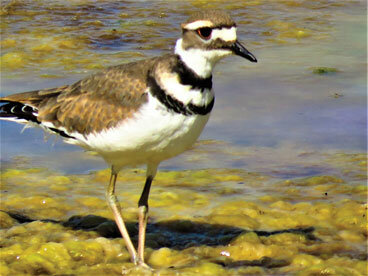
Photo courtesy Charles Martinez
This week’s Bird of the Week, compliments of the Weminuche Audubon Society and Audubon Rockies, is the killdeer.
This bird’s name doesn’t tell of a vicious behavior, but rather of a loud, high-pitched voice which sounds like it’s calling its name. The killdeer makes its characteristic calls in courtship displays, in flight and to sound the alarm if a predator comes near.
Unlike other shorebirds, this one is often found far from water in open habitats where the vegetation is less than 1 inch high. It is a familiar ground-dwelling bird on golf courses, lawns, parks and agricultural fields when it’s not feeding along a shoreline. The killdeer typically forages by running out and stopping to seize prey before dashing ahead again. It feeds on invertebrates including earthworms, beetles, grasshoppers and snails.
Laying its eggs in bare, open areas, the killdeer depends on camouflage to hide the nest. If a predator approaches, the adult will act vulnerable in a broken-wing display to lure it from the area, but if the threat is a large, hoofed animal, the parent will fan its tail over its back and run at it to divert its path from the nest.
The killdeer has a large, round head, large eyes and a short bill. It is robin-sized, brownish on top and white below. In flight, orange feathers on the rump and upper tail feathers are visible. Two black bands on the breast distinguish it from similar-looking plovers. Little puff-ball chicks have one breast band.
Pesticides used on lawns and fields pose both a direct threat of poisoning to these birds and an indirect threat when their food source is eliminated. People who allow their dogs to run loose in areas near the Riverwalk, where a newly hatched chick was recently seen, and around Vista Pond also pose a threat to these and other ground-nesting birds.
For information on events, visit www.weminucheaudubon.org and www.facebook.com/weminucheaudubon/.